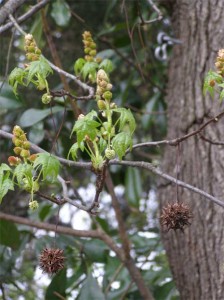
Lofty, maligned sweet gum

Male flowers of sweet gum standing proudly above the round cluster of female flowers hanging below. Photo by Ken Moore.
By Ken Moore
Sitting on the modest deck of Johnny’s on West Main Street, a short way from downtown Carrboro, one has an engaging view of a stately in-town sweet gum tree, Liquidambar styraciflua, in full flower. I have a hunch that you’ve not given much time to considering sweet gum flowers. Well, we can’t have all those generally despised sweet gum balls without first having the flowers.
I don’t recall when I first became aware of flowers on this tree; but now that I am, I look forward to them every spring.
Though it sports some of the most magnificent fall color of any native tree, the sweet gum is most often maligned as a “trash tree†because it is so common and it has all those messy spiked balls that litter the ground beneath. I rather like those spiky dried balls. While still hanging in the trees during the fall and winter, those dried gum balls hold seed that provide a favorite food for chickadees. Some years, I cut a big branch of sweet gum balls for indoor holiday decoration.
I remember a description in the esteemed garden publication of the English Royal Horticultural Society some years ago praising sweet gum balls as a suitable garden mulch. The English prize our native sweet gum as a single specimen tree with beautiful “autumn tints.â€
Go outside and find a sweet gum that is standing on the edge of a forest or out in an open landscape and take a “closer look.†The healthy mature ones at this time of year are decorated with what appear to be miniature candelabras, one at each leafy branch tip.
Those vertical clusters of reddish-green balls are the male flowers that will soon be bearing pollen for those singular little greenish balls hanging down beneath the young leaves at the branch tips. That little hanging ball is the female flower of many pistils awaiting airborne pollen to fall down upon them from all those proud guys sporting pollen above. If you can find one low enough, take a really good look, or use binoculars to bring them into closer view. You may be impressed. The flowers don’t have colorful petals, but they are beautiful in their own way.

Last year’s sweet gum balls still hanging while this year’s leaves and male and female flowers emerge above. Photo by Ken Moore.
Like so many of our native trees, the sweet gum is associated with a wealth of folk medicines and lore. Gum bark teas were used for numerous complaints and the sweet rosin (sweet gum) exuding from the cut bark and crushed leaves were applied to open wounds. The dried gum was used for gum disease or, as described in Paul Green’s Plant Book: “We children used to chop gashes in these trees and then later get the exuded gum and use it for chewing gum.â€
My favorite description is from Dr. Jim Duke’s Northeastern Indian Medicinal Plants: “Water or brandy-soaked twigs are chewed to clean the teeth in some areas of Appalachia.†Now that sounds a lot more fun than using conventional dental floss!
Give the sweet gum a closer look. For sheer beauty and architectural interest, I remain firm in holding the common sweet gum among my very favorite native trees.
from → Ken Moore's Flora, Spring

Comments are closed.